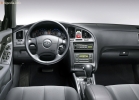Hyundai Elantra 4 doors 2000 - 2003 sedan
Available and solid
We decided to conduct an experiment in one test of different -aging models (according to the start date of production), which, nevertheless, are still produced and sold on the Russian market of new cars. Naturally, we selected cars belonging to the same class and, if possible, are not very different in price.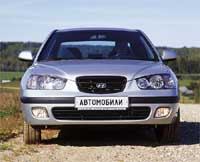 Thus, a motley team consisting of an old Renault Laguna (start of the 1993 release), mature Mitsubishi Carisma (1995) and Nissan Primera (1996), as well as a very young Hyundai Elantra (summer 2000), has. Renault, Mitsubishi and Nissan have already been modernized during their life, but this was mainly about cosmetic lifts and changes in the range of proposed engines. Renault Laguna is completely updated in the fall of this year, Carisma and Primera will live a couple of years, and Elantra is at least 5 years old.
Thus, a motley team consisting of an old Renault Laguna (start of the 1993 release), mature Mitsubishi Carisma (1995) and Nissan Primera (1996), as well as a very young Hyundai Elantra (summer 2000), has. Renault, Mitsubishi and Nissan have already been modernized during their life, but this was mainly about cosmetic lifts and changes in the range of proposed engines. Renault Laguna is completely updated in the fall of this year, Carisma and Primera will live a couple of years, and Elantra is at least 5 years old. All cars belong to the class D, and among the variety of modifications, we have chosen mediocre with 1800 cubic engines (all 4-cylinder, 16-valve) and mechanical gearboxes, but with a good level of equipment, air conditioning, abs, casting, electric packets, more- Less sophisticated music. Primera ($ 21,700) turned out to be the most expensive, significantly cheaper than Carisma (20 320) and Laguna (19,570), but the most affordable, naturally, Elantra Korean (17,200). Mindful that 4-door sedans are especially popular with us, Hyundai Elantra and Nissan Primera, we chose with this type of body (there are another 5-door hatchback). Renault Laguna 5-door hatchback (sedan was not produced), and among Mitsubishi Carisma modifications, we still stopped at the hatchback because it looks more attractive than the sedan.
In design, cars do not particularly differ from each other. All front -wheel drive with a transverse location of the power unit. Mitsubishi with direct injection of gasoline, which provides a winning in fuel consumption. With regard to the suspensions, Nissan stands out: in front is a two-legged, dependent on the mechanism of Scott-Rassel to perceive lateral efforts. You can also note the complex multi -tied rear Mitsubishi rear suspension.
Appearance, interior
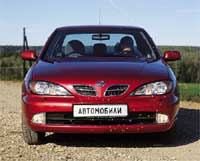 When all the participants in the test were built in a row for group photography, it was unexpected: Renault Laguna, wise with life experience, looked more attractive ... Despite her age, her style until now remains quite characteristic and harmonious and leaves a fresh impression. Mitsubishi Carisma has a different kind of beauty: everything is smooth, proportionally and concise, but not remembered and not remembered. Very similar to a standard beauty with the usual type advertising. It is even difficult to call a disadvantage, since many people need precisely the generally accepted appearance standard.
When all the participants in the test were built in a row for group photography, it was unexpected: Renault Laguna, wise with life experience, looked more attractive ... Despite her age, her style until now remains quite characteristic and harmonious and leaves a fresh impression. Mitsubishi Carisma has a different kind of beauty: everything is smooth, proportionally and concise, but not remembered and not remembered. Very similar to a standard beauty with the usual type advertising. It is even difficult to call a disadvantage, since many people need precisely the generally accepted appearance standard. The novelty of the Hyundai Elantra also stands out from the crowd, however, its visibility in another in the not entirely successful design of the front of the body is a peculiar face of the car. Most likely, the reason for the rejection is in a somewhat frivolous drawing of the radiator cladding, which is definitely foreign in relation to the rest, in general, a solid style, in which both the silhouette and the back of the body are solved. Most likely, after a couple of years, Elantra will be facilifting, which, let's hope, will be more successful.
Nissan Primera was restored last year. As a result, formerly modesty was lost, and the car began to look undoubtedly differently, acquiring a more aggressive appearance, mainly thanks to the predatory cuts of air intakes and the eye-far. The interiors of the whole four are less radical and more closely brought together both in equipment and decoration, and in style. Hyundai stands out, in which all the internal panels are made of hard plastic, and although his style does not claim to be greater originality, it is unlikely that he will cause anyone rejection. However, in all cases, the design of the interiors cannot serve as a decisive argument in favor or against the acquisition of these cars.
Ergonomics, capacity
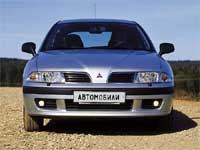 A set of adjustments that ensure the convenience of the driver’s work pose is quite large for all rivals. On Elantra, Carisma and Primera, the steering column is adjusted by inclination, and the seat pillow with two lambs can not only rise, but also change its slope. On Laguna, the steering wheel is adjusted along the length of the column, and the seat is lowered, climbed entirely. Renault steering wheel adjustment was the most successful and ensured the convenience of placing different physique to drivers. You can not complain about the layout of the driver's place Mitsubishi, but Hyundai and Nissan suffer from one, however, not a severe drawback: the relative location of the steering wheel and pedals is so that either the steering wheel is close to the driver or to the pedals you have to reach.
A set of adjustments that ensure the convenience of the driver’s work pose is quite large for all rivals. On Elantra, Carisma and Primera, the steering column is adjusted by inclination, and the seat pillow with two lambs can not only rise, but also change its slope. On Laguna, the steering wheel is adjusted along the length of the column, and the seat is lowered, climbed entirely. Renault steering wheel adjustment was the most successful and ensured the convenience of placing different physique to drivers. You can not complain about the layout of the driver's place Mitsubishi, but Hyundai and Nissan suffer from one, however, not a severe drawback: the relative location of the steering wheel and pedals is so that either the steering wheel is close to the driver or to the pedals you have to reach. The best driver's seat has Mitsubishi Carisma and Renault Laguna, and the first is a little more sports, and the second is more comfortable. But in both cases, the seat tightly covers the body, providing reliable side support. But the worst was the Hyundai Elantra seat, reminiscent of both shape and rigidity, rather not a chair, but a chair. This, of course, is an exaggeration, but the difference in comparison with Carisma and Laguna is huge. Nissan in this regard is a middle peasant.
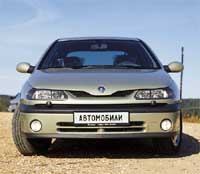 Another small detail site for the rest of the left leg. In Elantra, it is perfectly organized and highlighted with a special finish. In Laguna and Carisma, it does not stand out with emphasized finish, but nevertheless it is convenient, and in Nissan Primera it is a narrow ledge on a wheel niche, for which you hardly cling to the edge of the boot a trifle, but unpleasant. So, by the convenience of the driver’s location in the leaders Renault and Mitsubishi, but what about the convenience of passengers in the back seat? If we talk about the space for the legs, then the high advantage of Hyundai and Renault. When trying to sit back, the three of them revealed another, also a small plus of Hyundai sitting from the edge, not so strongly rested on their heads on the side slopes of the ceiling. In general, the capacity of passenger salons of all four cars cannot be called outstanding, as, for example, VW Passat or Peugeot 406, but there is nothing to scold for nothing.
Another small detail site for the rest of the left leg. In Elantra, it is perfectly organized and highlighted with a special finish. In Laguna and Carisma, it does not stand out with emphasized finish, but nevertheless it is convenient, and in Nissan Primera it is a narrow ledge on a wheel niche, for which you hardly cling to the edge of the boot a trifle, but unpleasant. So, by the convenience of the driver’s location in the leaders Renault and Mitsubishi, but what about the convenience of passengers in the back seat? If we talk about the space for the legs, then the high advantage of Hyundai and Renault. When trying to sit back, the three of them revealed another, also a small plus of Hyundai sitting from the edge, not so strongly rested on their heads on the side slopes of the ceiling. In general, the capacity of passenger salons of all four cars cannot be called outstanding, as, for example, VW Passat or Peugeot 406, but there is nothing to scold for nothing. Also, our four also looks even in the luggage compartment. Without folding the rear seat, Nissan wins by volume of the trunk, and loses to all Hyundai, but the difference between them is not so great. With a folded rear seat (and this is possible not only on the Laguna and Elantra hatchbacks), naturally, hatchbacks, especially Laguna, in which the luggage compartment volume grows to 1335 liters, is in winning. In fairness, it must be noted once again that Primera and Elantra are also produced in hatchback modifications.
Acceleration dynamics, braking
Four cars of almost the same weight and 1800-cow engines with not so much different output indicators all this foreshadowed the approximate equality of dynamics overclocking the test participants. This was confirmed by the dispersal indicators stated by firms to 100 km/h from the place. However, in reality, the four broke into two vapors significantly different from each other. The pair of leaders includes Renault Laguna and Hyundai Elantra their motors willingly spin and provide good craving in medium and high revolutions. At the same time, Renault is ahead of Hyundai thanks to the best elasticity of the engine. It's nice that the most active twisting of both motors is accompanied by moderate, and most importantly with a soft sound. Switching gears on these cars are quite long -term, but clear, especially in Elantra, on which each inclusion is accompanied by a clearly sensed transmission fixation.
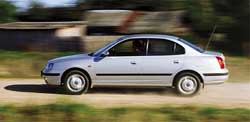 From a couple of outsiders, the Nissan Primera was especially disappointed with a lot of noise, and a rather rough tonality, with a very modest return, a striking difference from leaders. The gear shifts are short, but not very clear. Mitsubishi Carisma is quieter and much more dynamic than Primera, but she lacks vigor in the low -speed zone. Switching gear is medium both by strokes and clarity. As expected, the inhibition process in all four cars did not cause significant comments. For the first time, each of them, even in the city hustle and bustle, do not have difficulty with the accuracy of dosing on the pedal.
From a couple of outsiders, the Nissan Primera was especially disappointed with a lot of noise, and a rather rough tonality, with a very modest return, a striking difference from leaders. The gear shifts are short, but not very clear. Mitsubishi Carisma is quieter and much more dynamic than Primera, but she lacks vigor in the low -speed zone. Switching gear is medium both by strokes and clarity. As expected, the inhibition process in all four cars did not cause significant comments. For the first time, each of them, even in the city hustle and bustle, do not have difficulty with the accuracy of dosing on the pedal. Manageability, smoothness
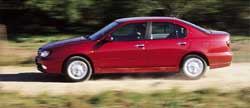 Finally, Nissan Primera got the opportunity to recoup her handling against the other participants in the test looks truly sports. The exact steering with high sensitivity and a good reactive effect, small bodies of the body and a large supply of stability in corners will bring true pleasure to lovers to prescribe the right trajectory on the winding paths. Not so far behind Primera and Laguna. Of course, it is softer in its reactions and more in turning in corners, but nevertheless it does not lose good understanding with the driver. Mitsubishi Carisma manageability does not have to scold, and there’s nothing to praise for. The behavior of the car does not strain the driver, but the trust dialogue between the person and the machine does not work. Carisma is a good vehicle, but not for active drivers.
Finally, Nissan Primera got the opportunity to recoup her handling against the other participants in the test looks truly sports. The exact steering with high sensitivity and a good reactive effect, small bodies of the body and a large supply of stability in corners will bring true pleasure to lovers to prescribe the right trajectory on the winding paths. Not so far behind Primera and Laguna. Of course, it is softer in its reactions and more in turning in corners, but nevertheless it does not lose good understanding with the driver. Mitsubishi Carisma manageability does not have to scold, and there’s nothing to praise for. The behavior of the car does not strain the driver, but the trust dialogue between the person and the machine does not work. Carisma is a good vehicle, but not for active drivers. Hyundai Elantra, but with one reservation, can be considered the same core for controllability. As soon as the speed goes beyond the limits of urban restrictions, the car begins to demand an almost constant fine correction by the steering wheel to maintain a straightforward movement. It seems that the steering drive lacks stiffness. This is not to say that this effect is strong enough to become dangerous, but the fact that it additionally loads the driver and reduces the pleasure of driving undoubtedly. In full accordance with the theory, the sports -controlled Primera is worse than rivals in the smoothness of the course. However, in this context it does not mean unacceptable. Yes, the suspension is harsh, but at the same time the energy intensive, so it copes with serious breakdowns.
 The Hyundai Elantra, by smoothness, reminded the best sports-oriented sedans from prestigious European manufacturers. I would like to call the nature of the suspension a harsh compound. Unevennesses are worked out by very economical passages of the suspension and transmitted to the body, although clearly, but elastic, without sharp blows. The connoisseurs of the comfort of the suspension in the traditional sense of the word will have to choose between Renault Laguna and Mitsubishi Carisma. In order to give preference to one of them, it is necessary to try significantly more different roads than we could have time.
The Hyundai Elantra, by smoothness, reminded the best sports-oriented sedans from prestigious European manufacturers. I would like to call the nature of the suspension a harsh compound. Unevennesses are worked out by very economical passages of the suspension and transmitted to the body, although clearly, but elastic, without sharp blows. The connoisseurs of the comfort of the suspension in the traditional sense of the word will have to choose between Renault Laguna and Mitsubishi Carisma. In order to give preference to one of them, it is necessary to try significantly more different roads than we could have time. Hyundai Elantra
+
1. The dynamics of acceleration
2. capacity
passenger salon
3. General sensation
solidity
-
1. Design
front part
car
2. lack of accuracy
steering
3. Form of the driver's seat
Nissan Primera
+
1. Sports
controllability
2. The volume of luggage
departments
-
1. Noisy
and not enough
the tracted motor
2. High
price
3. controversial
appearance
Mitsubishi Carisma
+
1. absence
significant
disadvantages
2. The shape of the seat
driver
-
1. absence
vivid advantages
Renault Lagun
+
1. Expressive,
almost unlucking
appearance
2. A good combination
controllability
and the smoothness of the course
3. The dynamics of acceleration
-
1. Model,
removed
from production
Results
So, she won Laguna both arithmetic and emotionally. Of course, several significant but. The most significant is so what is the legendary Japanese quality and reliability? We agree, this is not an empty phrase, but in fact we could prove it only by increasing the testing mileage once at 200-300. Therefore, we limit ourselves to those conclusions that can be drawn during a short first acquaintance.
 Laguna did not fail a single nomination of our test, occupying 1-2 places in each type of competition. Moreover, the car did not cause any significant complaints, if you do not take into account, of course, one important circumstance in a few months in our stores a completely new Laguna will appear. If, taking into account this, trade will reduce the price by several thousand, then the queue may form behind the French.
Laguna did not fail a single nomination of our test, occupying 1-2 places in each type of competition. Moreover, the car did not cause any significant complaints, if you do not take into account, of course, one important circumstance in a few months in our stores a completely new Laguna will appear. If, taking into account this, trade will reduce the price by several thousand, then the queue may form behind the French. Hyundai Elantra and without any discounts significantly cheaper than its rivals. At the same time, there are not so many reproaches to her: the curious grille of the radiator, the unsuccessful shape of the front seats and the lack of accuracy of the steering. In general, the new Elantra makes a much more solid impression than her predecessor. If you are not very worried about the cost of the car and you are not a special fan of the active control manner, then perhaps the best choice will be Mitsubishi Carisma. This is a vivid example of a pleasant car in every way. It is beautiful, convenient and practical (although poorly). Add to this a 3-year guarantee, and its popularity in Russia will become clear.
The feeling of some disappointment was left only by the Nissan Primera and, mainly due to the engine: the dynamics of acceleration clearly does not correspond to the noise support of the motor. It's a shame, especially against the background of excellent handling of this car. The test conducted convincingly showed that well -preserved parents can often give odds to not too experienced children.
Roman Sergeev
Photo by Alexander Nozdrin
A source: Cars
Hyundai Elantra 4 doors 2000 - 2003 Video
Hyundai Elantra 4 doors 2000 - 2003 test drives
Hyundai Elantra 4 doors 2000 - 2003
Krassh Test: Detailed Information20%
Driver and passengers
16%
Pedestrians




